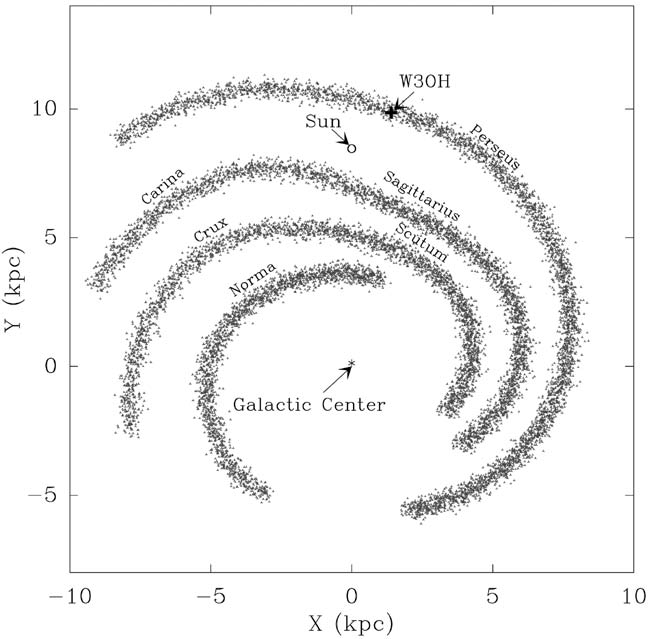Astronomers Measure Distance to Milky Way's Spiral Arm

Astronomers can provide detailed images of beautifullyswirling galaxies millions of miles away. It's our own galaxy they haven't beenable to get their arms around.
"It's clear that the Milky Way has a structure like those,but it's hard to tell being in it," said Mark Reid of the Harvard-SmithsonianCenter for Astrophysics.
Now, a team of astronomers has taken an important steptoward mappingthe Milky Way by accurately measuring the distance to the star-formingregion W3OH in the Perseus spiral arm, the nearestarm to us. This long strand of stars streaks out of the Milky Way's disk in thesame manner as others seen in galaxies across the universe.
Until now scientists had difficulties figuring just how faraway spiral arms are, and various measurements and techniques had discrepanciesranging by a factor of two.
The new results are from a telescope nearly the size ofEarth. The astronomers used the Very Long Baseline Array, taking observationsfrom several telescopes stretching from Hawaii to the Virgin Islands, to createthe resolution of a telescope nearly 5,000 miles in diameter.
"We have established that the radio telescope we used, theVery Long Baseline Array, can measure distances with unprecedentedaccuracy--nearly a factor of 100 times better than previously accomplished,"Reid said.
In doing so, they determined that W3OHis 1.95?0.04 kiloparsecs away. That's about36,000,000,000,000,000 miles.
Breaking space news, the latest updates on rocket launches, skywatching events and more!
Although the VLBA has extremely high resolution, the sourceobjects need to be very bright and compact. Spiral arms are just that--brightclouds of star-forming gas. In particular, this team focused in on a cloud ofmethyl alcohol surrounding a newly formed star.
"We measured distance by the simplest and most direct methodin astronomy--essentially the technique used by surveyors called triangulation,"said team member Xu Ye.
This technique, also known as parallax, comes straight outof a high school geometry textbook. In this case, theresearchers used the changing vantage point from the Earth as it orbits the Sunto form one leg of the triangle. Then, they calculated the star's distance bymeasuring the change in its position as Earth orbits the Sun.
The astronomers found that this young star is actuallymoving around the Milky Way in an orbit that is about 10 percent off from beingcircular. It appears to rotate slower than other stars in circular orbits andis falling toward the center of the Milky Way.
Although scientists don't really understand the details ofspiral arm formation, these observations support the "spiral density-wavetheory." This theory suggests that a combination of gravitational instabilitiesand shear forces--a result of the outer edge of the galaxy moving slower thanthe inner--cause material to cluster and eventually shoot off in an arm.
The researchers are now shifting the VLBA'sgaze toward three other spiral arms where they will look at about a dozen star-formingareas similar to W3OH.
This research is detailed today in the online version of thejournal Science.
- The Milky Way: A Tourist's Guide
- Spirals in Nature: The Magical Number behind Hurricanes and Galaxies
- Milky Way's Central Structure Seen with Fresh Clarity
